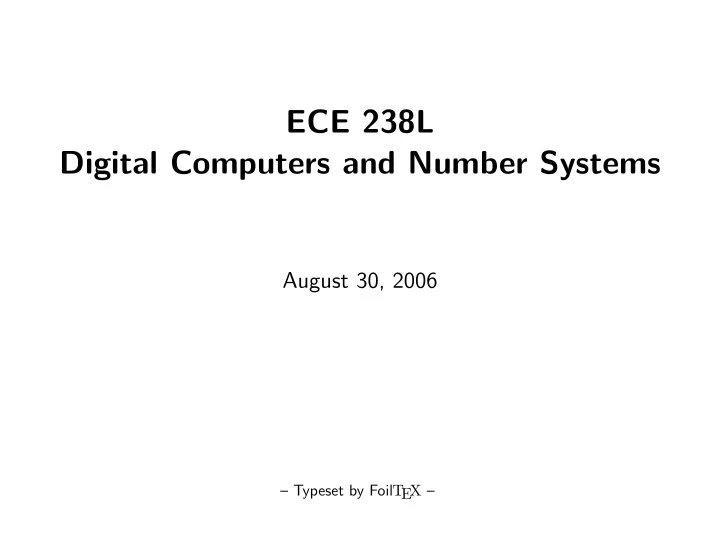

ECE 238L Digital Computers and Number Systems August 30, 2006 – Typeset by Foil T EX –
Computers are everywhere • Computers are ubiquitous – used everywhere. Cell phones, street lights, watches, calculators, ... • Computers are flexible and can be reprogrammed. • Computers operate on discrete elements (sets, information, etc.) – Typeset by Foil T EX – 1
Discrete Elements – the basis of a computer • Discrete elements are represented as signals. • Most elements can have two values, e.g. binary. • The values can be HIGH, LOW, True, False, 1, 0, etc. • Binary representations are convenient and reliable. – Typeset by Foil T EX – 2
Generic Computer Monitor Disk I/O Controller Controller Graphics Keyboard Bus Adapter Interface FPU MMU CPU Cache RAM Processor Cache – Typeset by Foil T EX – 3
Positional Numbers 527 . 46 10 = (5 × 10 2 )+(2 × 10 1 )+(7 × 10 0 )+(4 × 10 − 1 )+(6 × 10 − 2 ) 527 . 46 8 = (5 × 8 2 ) + (2 × 8 1 ) + (7 × 8 0 ) + (4 × 8 − 1 ) + (6 × 8 − 2 ) 527 . 46 5 = illegal – why? 101011 . 11 2 = (1 × 2 5 )+(0 × 2 4 )+(1 × 2 3 )+(0 × 2 2 )+(1 × 2 1 )+ (1 × 2 0 ) + (1 × 2 − 1 ) + (1 × 2 − 2 ) This works for binary as well... – Typeset by Foil T EX – 4
Binary Numbers 101011 . 11 2 = (1 × 2 5 )+(0 × 2 4 )+(1 × 2 3 )+(0 × 2 2 )+(1 × 2 1 )+ (1 × 2 0 ) + (1 × 2 − 1 ) + (1 × 2 − 2 ) n 2 n n 2 n 0 1 8 256 1 2 9 512 2 4 10 1024 3 8 11 2048 4 16 12 4096 5 32 13 8192 6 64 14 16384 7 128 15 32768 – Typeset by Foil T EX – 5
Octal and Hexadecimal Octal is base eight. More compact than binary. Base-8 uses which digits? 127 . 4 8 = 1 × 8 2 + 2 × 8 1 + 7 × 8 0 + 4 × 8 − 1 = 87 . 5 10 Hexidecimal is base 16. First 10 digits are decimal and the next 6 are from the alphabet (A → 10, B → 11,C → 12,D → 13, E → 14, F → 15). B65F 16 = 11 × 16 3 + 6 × 16 2 + 5 × 16 1 + 15 × 16 0 = 46687 10 – Typeset by Foil T EX – 6
Binary Numbers 101011 . 11 2 = (1 × 2 5 )+(0 × 2 4 )+(1 × 2 3 )+(0 × 2 2 )+(1 × 2 1 )+ (1 × 2 0 ) + (1 × 2 − 1 ) + (1 × 2 − 2 ) Convert to Base 10: = 32 + 0 + 8 + 0 + 2 + 1 + 1 / 2 + 1 / 4 = 43 . 75 10 – Typeset by Foil T EX – 7
Convert 112 from base 10 to binary 112 1 × 2 6 - 64 48 1 × 2 5 - 32 16 1 × 2 4 - 16 0 ↓ 112 10 = 1110000 2 0 × 2 3 - 0 0 0 × 2 2 - 0 0 0 × 2 1 - 0 0 0 × 2 0 - 0 0 – Typeset by Foil T EX – 8
An Alternate way to convert 112 from base 10 to binary. 2 112 2 56 R 0 2 28 R 0 2 14 R 0 ↑ 112 10 = 1110000 2 2 7 R 0 2 3 R 1 2 1 R 1 0 R 1 – Typeset by Foil T EX – 9
Converting fractions from base 10 to binary: convert . 7 10 to binary . 7 . 7 10 = . 1 0110 0110 0110 ... × 2 (1) . 4 × 2 (0) . 8 × 2 ↓ (1) . 6 × 2 (1) . 2 × 2 ← process starts repeating (0) . 4 × 2 here. (0) . 8 – Typeset by Foil T EX – 10
Hexadecimal • Commonly used for binary data 1 hex digit == 4 binary digits (bits) • Need more digits (than decimal) – Use 0-9, A-F ∗ A-F are for 10-15 FA2 16 = 15 × 16 2 + 10 × 16 1 + 2 × 16 0 FA2 16 = 1111 ���� 1010 0010 Each group of 4 bits ⇐ ⇒ 1 hex digit – Typeset by Foil T EX – 11
Numbers with different Bases Decimal Binary Octal Hexadecimal Base 10 Base 2 Base 8 base 16 00 00000 00 00 01 00001 01 01 02 00010 02 02 03 00011 03 03 04 00100 04 04 05 00101 05 05 06 00110 06 06 07 00111 07 07 08 01000 10 08 09 01001 11 09 10 01010 12 0A 11 01011 13 0B 12 01100 14 0C 13 01101 15 0D 14 01110 16 0E 15 01111 17 0F 16 10000 20 10 – Typeset by Foil T EX – 12
Recommend
More recommend